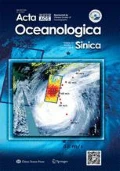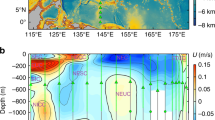Abstract
The spatial and temporal variations of turbulent diapycnal mixing along 18°N in the South China Sea (SCS) are estimated by a fine-scale parameterization method based on strain, which is obtained from CTD measurements in yearly September from 2004 to 2010. The section mean diffusivity can reach ~10–4 m2/s, which is an order of magnitude larger than the value in the open ocean. Both internal tides and wind-generated near-inertial internal waves play an important role in furnishing the diapycnal mixing here. The former dominates the diapycnal mixing in the deep ocean and makes nonnegligible contribution in the upper ocean, leading to enhanced diapycnal mixing throughout the water column over rough topography. In contrast, the influence of the wind-induced near-inertial internal wave is mainly confined to the upper ocean. Over both flat and rough bathymetries, the diapycnal diffusivity has a growth trend from 2005 to 2010 in the upper 700 m, which results from the increase of wind work on the near-inertial motions.
Similar content being viewed by others
References
Alford M. 2001. Internal swell generation: the spatial distribution of energy flux from the wind to mixed layer near-inertial motions. J Phys Oceanogr, 31(8): 2359–2368
Alford M H. 2003. Improved global maps and 54-year history of windwork on ocean inertial motions. Geophys Res Lett, 30(8): 1424
Alford M H, Peacock T, MacKinnon J A, et al. 2015. The formation and fate of internal waves in the South China Sea. Nature, 521(7550): 65–69
Egbert G D, Ray R D. 2001. Estimates of M2 tidal energy dissipation from TOPEX/Poseidon altimeter data. J Geophys Res, 106(C10): 22475–22502
Ge Lili, Cheng Xuhua, Qi Yiquan, et al. 2012. Upper-layer geostrophic volume, heat and salt transports across 18°N in the South China Sea. J Trop Oceanogr (in Chinese), 31(1): 10–17
Gill A E, Green J S A, Simmons A J. 1974. Energy partition in the largescale ocean circulation and the production of mid-ocean eddies. Deep-Sea Res: Oceanogr Abstr, 21(7): 499–528
Gregg M C. 1987. Diapycnal mixing in the thermocline: a review. J Geophys Res, 92(C5): 5249–5289
Gregg M C, Kunze E. 1991. Internal wave shear and strain in Santa Monica basin. J Geophys Res, 96(C9): 16709–16719
Gregg M C, Sanford T B, Winkel D P. 2003. Reduced mixing from the breaking of internal waves in equatorial ocean waters. Nature, 422(6931): 513–515
Jayne S R, St Laurent L C. 2001. Parameterizing tidal dissipation over rough topography. Geophys Res Lett, 28(5): 811–814
Jing Zhao, Wu Lixin. 2010. Seasonal variation of turbulent diapycnal mixing in the northwestern pacific stirred by wind stress. Geophys Res Lett, 37(23): L23604
Jing Zhao, Wu Lixin. 2014. Intensified diapycnal mixing in the midlatitude western boundary currents. Sci Rep, 4: 7412
Jing Zhao, Wu Lixin, Li Lei, et al. 2011. Turbulent diapycnal mixing in the subtropical northwestern pacific: spatial-seasonal variations and role of eddies. J Geophys Res, 116(C10): C10028
Kunze E, Firing E, Hummon J M, et al. 2006. Global abyssal mixing inferred from lowered ADCP shear and CTD strain profiles. J Phys Oceanogr, 36(8): 1553–1576
Kunze E, Kennelly M A, Sanford T B. 1992. The depth dependence of shear finestructure off Point Arena and near Pioneer Seamount. J Phys Oceanogr, 22(1): 29–41
Li Ying, Xu Yongsheng. 2014. Penetration depth of diapycnal mixing generated by wind stress and flow over topography in the northwestern pacific. J Geophys Res, 119(8): 5501–5514
Munk W, Wunsch C. 1998. Abyssal recipes: II. Energetics of tidal and wind mixing. Deep-Sea Res: I, 45(12): 1977–2010
Pollard R T, Millard R C. 1970. Comparison between observed and simulated wind-generated inertial oscillations. Deep-Sea Res: Oceanogr Abstr, 17(4): 813–816
Polzin K L, Toole J M, Schmitt R W. 1995. Finescale parameterizations of turbulent dissipation. J Phys Oceanogr, 25(3): 306–328
Tian Jiwei, Yang Qingxuan, Zhao Wei. 2009. Enhanced diapycnal mixing in the South China Sea. J Phys Oceanogr, 39(12): 3191–3203
Waterhouse A F, Mackinnon J A, Nash J D, et al. 2014. Global patterns of diapycnal mixing from measurements of the turbulent dissipation rate. J Phys Oceanogr, 44(7): 1854–1872
Whalen C B, Talley L D, MacKinnon J A. 2012. Spatial and temporal variability of global ocean mixing inferred from Argo profiles. Geophys Res Lett, 39(18): L18612
Wu Lixin, Jing Zhao, Riser S, et al. 2011. Seasonal and spatial variations of Southern Ocean diapycnal mixing from Argo profiling floats. Nat Geosci, 4(6): 363–366
Wunsch C, Ferrari R. 2004. Vertical mixing, energy, and the general circulation of the oceans. Annu Rev Fluid Mech, 36(1): 281–314
Yang Haiyuan, Wu Lixin. 2012. Trends of upper-layer circulation in the South China Sea during 1959–2008. J Geophys Res, 117(C8): C08037
Zhai Xiaoming, Greatbatch R J, Eden C, et al. 2009. On the loss of wind-induced near-inertial energy to turbulent mixing in the upper ocean. J Phys Oceanogr, 39(11): 3040–3045
Acknowledgements
The authors thank the Key Laboratory of Tropical Marine Environment Dynamics, the South China Sea Institute of Oceanology, Chinese Academy of Sciences for providing the CTD data. We are grateful for the suggestions from Yang Qingxuan.
Author information
Authors and Affiliations
Corresponding author
Additional information
Foundation item: The National Basic Research Program (973 Program) of China under contract No. 2013CB956201; the National Natural Science Foundation of China under contract Nos 41521091, U1406401 and 41622602; the Global Change Project under contract No. GASI-03-01-01-05.
Rights and permissions
About this article
Cite this article
Liu, Y., Jing, Z. & Wu, L. The variation of turbulent diapycnal mixing at 18°N in the South China Sea stirred by wind stress. Acta Oceanol. Sin. 36, 26–30 (2017). https://doi.org/10.1007/s13131-017-1067-2
Received:
Accepted:
Published:
Issue Date:
DOI: https://doi.org/10.1007/s13131-017-1067-2



